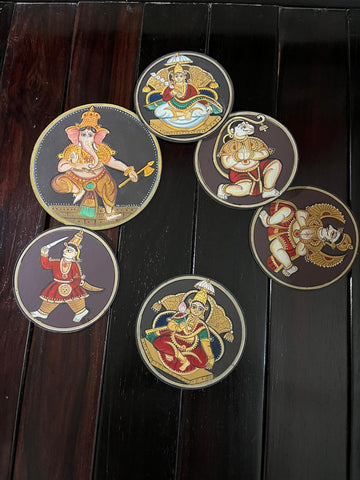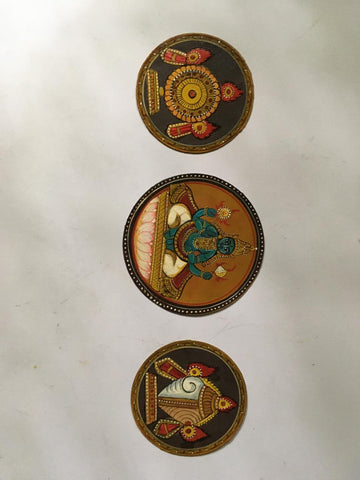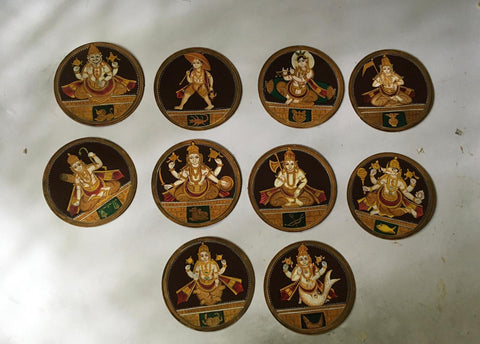Mysore Ganjifa is a popular game that was once patronised by the royal family of Wodeyar, Mysore, and was famous across the entire kingdom, locally known as Chadd or 'God's play.' The objective of the game was to teach stories from the ancient scriptures and holy books. The game had 18 themes that included stories from the Hindu Puranas, epics such as Ramayana and Mahabharata, and different shlokas. Among these, the Dashavatar Ganjifa was considered one of the best. Today, this style of game is only played in the city of Mysore, the erstwhile capital of the kingdom. The cards used in this game are typically circular in shape, depicting Hindu deities like Vishnu, Krishna, and Saraswati. The artwork is intricate and detailed, with vibrant colours and elaborate designs. The cards were often made of ivory or mother-of-pearl, and sometimes decorated with precious gemstones.

Mysore ganjifa
If you want to see the original centuries-old Ganjifa paintings, you can visit the Jagan Mohan Palace in Mysore, the Folk Art Museum in Mysore, the Ganjifa Museum at Srirangapattna, and the Manjusha Museum at Dharamshala.

Vishnu with shankh and chakra
HISTORY
King Mummadi Krishnaraja of the Wodeyar dynasty was a great patron of the Mysore Ganjifa. Under his reign, the game developed 18 new themes such as Chamundeshwari, Panchapandavas, Jagan Mohona, Navagraha, Ashtadikpala, Mahisha Mardana, Naveena Rama, Naveena Dashavatara, Sadyujata, Sri Krishnaraja, Devi Dashavatara, Manohara, Sarva Mangala, Navaratna, Ramayana, Dashavatar, Sarvasamrajya, and Astaishwarya. The Krishnaraja Ganjifa was named after King Krishnaraja, and each suit used symbols of the Wodeyar dynasty, such as haathi or the elephant, gandaberunda or the double-headed eagle, jatayu or vulture, gaja virala or the lion, and Makara or the crocodile. He recorded the details of the Ganjifa game in his book, Sritattvanidhi, written in 1818.
The Mysore Ganjifa was played similarly to the Mughal Ganjifa, but the number of cards varied from 36 to 360. The Mysore Ganjifa was painted in the typical painting style of Vijayanagara, with thin lines and heavy ornaments.

Ashtalakshmi
PROCESS
The process of creating the Ganjifa cards starts with the preparation of the canvas. The artists soak starch-free cotton in a solution of crushed Tamarind seeds and water for four to five days. Once soaked, they place two layers of cloth one over another to get a thick canvas. It is then sun-dried till stiff. The artists prepare another paste using chalk powder, crushed tamarind seeds, and natural gum, which is then applied on both sides of the prepared cloth. This provides a stiff hard base to work on. Once ready, the canvas is buffed using local stones. The Canvas is then cut into the desired shapes, generally circles or squares.
The artists use organic materials to prepare dyes, such as conch shell or clay for white, leaves for green, lamp soot for black, hingulal stone or a mixture of turmeric and lime for red, khandneela stone or indigo for blue, hartal stone or turmeric for yellow, local mud for maroon, and yellow ochre.
There are specific steps followed to prepare the Ganjifa cards. The first step is demarcating the border, creating a space within which the artists would work. It is generally drawn around the edge of the canvas. Since the themes of the cards are religious in nature, the artist starts with a prayer. It is followed by painting the outlines of figures with white, followed by their clothes and ornaments. Traditionally, the artists used gold leaf for the ornaments. Once the main figure is painted, the artists then paint the secondary motifs and outline them with black. The last step is the painting of the eyes, after which the painting is considered complete.

Dashavatar
TYPES OF MYSORE GANJIFA
There are three distinct types of Mysore Ganjifa paintings - Paintings with plain gold foil without embossing, paintings with embossing, and paintings with Makki Safeda work in which the base is painted first, after which the shades of white are painted.
CONCLUSION
During the British period, like other crafts of India, Mysore Ganjifa declined. After almost a century, there have been significant efforts to revive the art. Shri Raghupati Bhatta has played an important role in reviving the craft. He chanced upon the 200-year-old Ganjifa paintings and was fascinated by their lustre. Later, he successfully recreated the Ganjifa paintings and has trained hundreds of artists in this art form. He also established the Ganjifa Art Museum in SriRangapatna in 1991.
- “Mysore Ganjifa.” MAP Academy, July 26, 2023. https://mapacademy.io/article/mysore-ganjifa/.
- Ghosh, Sanjukta. “Exploration on Two GI Clusters of Mysore - Ganjifa Cards of Mysore & Mysore Traditional Painting.” Srishti Institute of Art Design and Technology, n.d.
- “Ganjifa: Mysore Painting.” Scribd. Accessed February 29, 2024. https://www.scribd.com/presentation/128436345/ganjifa.
- “Mysore Ganjifa from Famous Raghunath Bhatt.” Mysore Ganjifa from Famous RaghunathBhat | Home. Accessed February 29, 2024. https://mysoreganjifa.com/.






















